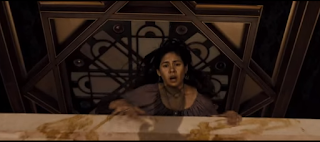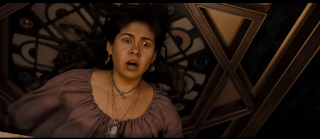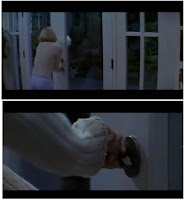We analysed film ratings so that we could promote our film towards the most effective audience and designated niche market. Typically horrors are not governed towards any ideal audience under the age of 15. however, the woman in black stands as an exception because it is a historical classic novel that was deemed acceptable by the BBFC in addition to the horror based film 'the hole'. 'The Hole' was accepted as a twelve rating predominantly because of the usage of young upcoming actors featuring in CBBC and CITV programs. We considered making our film a 12 because we wanted the opening to focus on an effective inventive story-line and plot rather than just aspects of horror and scary or gory scenes. If there was actually a moral behind our story it could be classified as a 12 and therfore appeal to a wider and more broadly aged audience..this means we could still include jump scares and possibly disturbing scenes without the usage of strong gore and death. Usually most 12 films are action movies or thrillers, so our movie would be distinctive and we would have to argue our reasons for allowing a horror based thriller to be a 12 certificate. The BBFC state that some horrors may be passed under the 12/12A category with moderate physical and psychological threat permitted along as horror scenes are infrequent with an overall tone that isn't disturbing and infrequent swearing or taboo language or nudity. Also, twelve rated films cannot involve harsh incorrect drug usage or promotion-which our film wouldn't. We were thinking of having a focus in our film on alcohol abuse with a driver involved who acts as if he had been heavily drinking, however we haven't confirmed this idea and need to further work on the age rating for this type of alcoholism.
The most obvious choice for a horror film rating is to aim it at a 15+ audience because this would appeal to teenagers who enjoy the idea of being scared and going to the cinema as a planned event to watch a horror movie. Also a 15+ audience would be more mature and therefore the story-line could touch on different more adult topics. film examiners look at issues when rating a film such as discrimination, drugs, horror themes, imitable behavior, language, nudity, sex and sexual violence and theme. The idea of imitable behavior is a subject to be carefully considered when creating our film because any ideas of danger or violence need to be considered as to what audience we are portraying this to, especially with our idea of the inclusion of roadside issues and reckless driving. Films are also considered under context, tone and impact of how it may make an audience feel; there is also the consideration of the release format- for example if it is released on DVD is there a higher risk of underage viewing. 15 films accept racist, homophobic and discriminatory language as well as strong taboo words and even the strongest language terms like f**k and c**t (depending on manner of use). 15 films are also allowed to include lengthy sexual activity and nudity in a sexual context without strong detail. 15 films also allow strong violence however no dwelling on the infliction of pain or injury, strong sadistic violence is however unacceptable and continually gory films are rated 18s. 15 films allow detailed verbal references to sexual violence for example descriptions of rape or sexual assault in a courtroom scene or in testimony however depiction of sexual violence is not allowed or must alternatively be completely justified in context of the story-line of the film. We know that our horror wouldn't break any of the 15 rating boundaries because there can be strong threat and dark horror as long as there is not a sustained focus on sadistic and sexualised horror and threat- which wouldn't be flaunted at all in our film.
i wanted to research how 18 films differed so wildly from the 15 rating and why you need to be within adulthood for watching 18 movies. when i analysed the film rating, it realized that it was because of inclusions of very strong violence, strong and frequent language, strong horror and sexual activity as well as sexual violence, blood and gore and discriminatory language and behavior. at 18 there is no themes prohibited and adults are free to choose their own entertainment providing the material is not illegal or harmful- this means that this particular categorization for film ratings can even be offensive to adult viewers. Although adults can watch what they want- there is potential aspects that could be cut from an 18 movie if there is material that breaches the criminal law or where material has very detailed portrayal of illegal drug use and sexual and strong violence for example making rape look appealing. Rating a film an 18 cuts out 25% of movie goers as 15% are aged 2-11 and 10% 12-17. This means that by making our movie a 15 we would have a wider audience to promote our film to, as teenagers make up a wide population (at least 8% are 15) and would create more of a broad viewing population & income.
The most obvious choice for a horror film rating is to aim it at a 15+ audience because this would appeal to teenagers who enjoy the idea of being scared and going to the cinema as a planned event to watch a horror movie. Also a 15+ audience would be more mature and therefore the story-line could touch on different more adult topics. film examiners look at issues when rating a film such as discrimination, drugs, horror themes, imitable behavior, language, nudity, sex and sexual violence and theme. The idea of imitable behavior is a subject to be carefully considered when creating our film because any ideas of danger or violence need to be considered as to what audience we are portraying this to, especially with our idea of the inclusion of roadside issues and reckless driving. Films are also considered under context, tone and impact of how it may make an audience feel; there is also the consideration of the release format- for example if it is released on DVD is there a higher risk of underage viewing. 15 films accept racist, homophobic and discriminatory language as well as strong taboo words and even the strongest language terms like f**k and c**t (depending on manner of use). 15 films are also allowed to include lengthy sexual activity and nudity in a sexual context without strong detail. 15 films also allow strong violence however no dwelling on the infliction of pain or injury, strong sadistic violence is however unacceptable and continually gory films are rated 18s. 15 films allow detailed verbal references to sexual violence for example descriptions of rape or sexual assault in a courtroom scene or in testimony however depiction of sexual violence is not allowed or must alternatively be completely justified in context of the story-line of the film. We know that our horror wouldn't break any of the 15 rating boundaries because there can be strong threat and dark horror as long as there is not a sustained focus on sadistic and sexualised horror and threat- which wouldn't be flaunted at all in our film.
i wanted to research how 18 films differed so wildly from the 15 rating and why you need to be within adulthood for watching 18 movies. when i analysed the film rating, it realized that it was because of inclusions of very strong violence, strong and frequent language, strong horror and sexual activity as well as sexual violence, blood and gore and discriminatory language and behavior. at 18 there is no themes prohibited and adults are free to choose their own entertainment providing the material is not illegal or harmful- this means that this particular categorization for film ratings can even be offensive to adult viewers. Although adults can watch what they want- there is potential aspects that could be cut from an 18 movie if there is material that breaches the criminal law or where material has very detailed portrayal of illegal drug use and sexual and strong violence for example making rape look appealing. Rating a film an 18 cuts out 25% of movie goers as 15% are aged 2-11 and 10% 12-17. This means that by making our movie a 15 we would have a wider audience to promote our film to, as teenagers make up a wide population (at least 8% are 15) and would create more of a broad viewing population & income.















